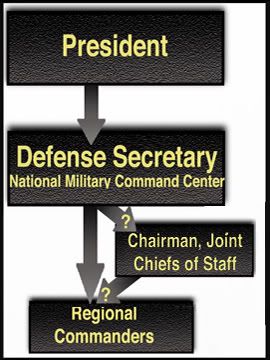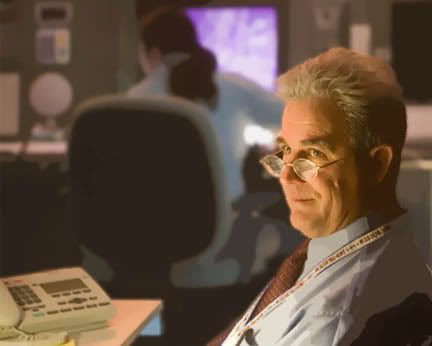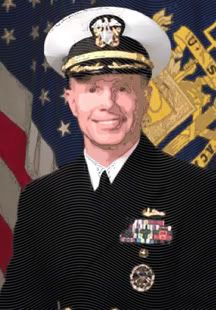Ben Sliney’s Odd Initiation
Adam Larson
Caustic Logic / They Let It Happen
March 22 2007 | Benedict Sliney, on the set of “Flight 93,” (2006), reliving his high-pressure first day as FAA national operations manager |
Besides the NMCC and Joint Chiefs of Staff, the Federal Aviation Administration, through whose system the 9/11 attacks occurred, was in weird hands on that weird day. Benedict Sliney had experience with FAA air traffic control dating back to 1964, but from the early 1980s took an 18-year hiatus to practice law in Manhattan. [1] He made a name for himself defending NY’s transit authority against passenger lawsuits, and once suing the FAA on behalf of fellow air traffic controllers. He gave up law in mid-2001, which he surrendered only, he says, after his 72-year-old secretary unexpectedly retired.
“I could not work without her, […] I wasn't going to continue. I didn't like law anyhow, it paid well, but it's very demanding in terms of time. I maintained my friendship of course with people in the FAA. The person in charge of the command center asked me, when I would complain about the law to come back to the FAA and I did.” [2]
This was apparently in mid-2001 when some combination of FAA connections, leadership skills, whatever, gave him a sudden career change back to the Administration, and straight to the top: National Operations Manager, a short, powerfully titled post described by
USA Today as “the chess master of the air traffic system.” The paper explained “when he accepted the job overseeing the nation's airspace a few months earlier, Sliney wanted to be sure he had the power to do the job as he saw fit. "What is the limit of my authority?" he asked the man who had promoted him. "Unlimited," he was told.” [3] He got the job, and over the next several weeks set to re-learning the ropes and the two decades of technological and procedural changes since his old days.
It was hoped he’d learn enough to fulfill his normal, routine, functions. But Sliney’s new job also made him the man who would, theoretically, be responsible for such unprecedented things as ordering nationwide ground-stop of all air traffic, not that it ever had been an issue before. And he would also be the very guy in charge of requesting fighter assistance in the event of a suicide hijacking, on the off-chance that should ever be needed, which also had never ever happened once in the US. So perhaps understandably, these more esoteric duties were seemingly passed over a bit.
Tuesday being the slowest air travel day, little was expected (?) as Sliney clocked in for his first day at the FAA national operations center in Herndon Virginia, smack between Dulles Airport, the capital, and the Pentagon, at some time before 8:00 am on September 11. But it didn’t stay quiet for long; “It was a very short time,” Sliney later remembered, before he received the first clue this day would not be routine. At about 8:25 am, one of his assistant informed him “that they had an admission that a flight attendant was stabbed. Now it's starting to take a road that we hadn't been down before. It swiftly escalated after that.” [4] Somewhat less swiftly, the FAA response to the unfolding attack, largely overseen by Sliney, was measured, graduated:
8:15-20ish – Numerous calls sent to FAA from flight attendants Ong and Sweeney onboard Flight 11, clearly telling of a hijacking in progress.
8:24 - a transmission intended for the passengers on Flight 11 but accidentally sent system-wide by the hijackers, was received: "We have some planes. Just stay quiet and you will be OK." After Sliney learned of this line,
USA Today reported, “the words will haunt him all morning. "We have some planes." Some? How many?” [5]
Before 8:46 – Sliney later described “an unidentified aircraft,” that is, with no transponder, “at 16,000 feet approaching New York City from the northwest at a pretty moderate ground speed of 300 knots. No one was working and we did not know who the aircraft was.” [6] Without transponders, we're told, it was hard to tell one of the thousands of blips from the next (which, if true, made the system completely useless)
8:46-8:50 - Sliney receives word from New York of a “small plane” crash into the World Trade Center. They turn on CNN in the control center. “That was no small plane, Sliney thinks.” Within minutes his suspicions were confirmed: it was the missing AA11. [7]
9:03 – The second plane, UA175, hits the second tower, and New York’s air space is ordered shut down, a multi-state area cleared of air traffic in the first such unprecedented move of the morning. Realizing this is an attack, and twenty minutes into it, Sliney scrambles to make up for lost time. It was time for bold – but not hasty - action.
9:15 – American Airlines orders no more AA takeoffs in the northeast. No concrete moves from Sliney in Herndon yet, just listing all troubled, possibly hijacked flights on a dry erase board. “The moves aren't strong enough for some of the air traffic specialists at the center,” says USA Today, “who bombard Sliney with advice. "Just stop everything! Just stop it!" The words ring true to Sliney.” [8] Haunted by knowledge of more planes, Sliney responds. Seconds tick by. (one mississippi, two mississippi, three mississippi... ten more minutes pass)
9:25 - AA77 has now been unaccounted for as well, for thirty minutes. Sliney issues another unprecedented order: full groundstop. No FAA controlled flights are to take off, anywhere in the country. The skies are full enough, but it wasn't yet time to order them cleared altogether.
“Amid the shouts and chatter and conflicting reports,” USA Today reported, Sliney “reminds himself: Don't jump to conclusions. Sort it out.” Indeed, deliberation seems his strong point: “since the second Trade Center tower was hit, Sliney has considered bringing every flight down,” the paper reported. It wasn’t until after the Pentagon was hit with AA77 at 9:38 that “the manager in charge of the nation's air traffic system is certain. He has no time to consult with FAA officials in Washington,” and made his snap decision all on his own to have all air traffic get out of the sky ASAP. "Order everyone to land! Regardless of destination!" Sliney shouted, since shouting helps orders get back in time to when they might have done some good. [1] The 9/11 Commission agreed that Sliney “ordered all FAA facilities to instruct all aircraft to land at the nearest airport” at exactly 9:42, 56 minutes after the first strike of the war against his native New York, an hour and twenty minutes after the first hijacking was known of.
Is that slow or fast? There’s not much precedence to judge by, but a faster response is at least feasible, by Sliney’s own account. US News reported in June 2004 that “he says he would have stopped everyone sooner,” had he not been left out of the pre-9/11 terror warning loop. Ominous predictions that had been issued that summer about al Qaeda’s potential air designs “never reached key people like Benedict Sliney.” [10] Whoever preceded Sliney in the NOM position likely had been aware of the threat, considering for example, the August 2001 CIA memo "Islamic Extremist Learns to Fly," and the high-level meeting Richard Clarke called on July 5, including FAA, and warning “something really spectacular is going to happen here, and it’s going to happen soon.” But the manager who might’ve known the score on what to expect, and probably had a better understanding of what could be done in response, was just not working out. And his replacement, being a first-day rookie not clued into the earlier threat assessments, was in effect a blank spacer inserted, by chance we are to believe, into a key spot in the air defense system.
Sliney was not the top link at FAA, of course. He had superiors like FAA administrator Jane Garvey and her deputy Monte Belger, and running all the way up to Transportation Secretary Norman “fuck pilot discretion” Mineta, in the PEOC beneath the White House with Cheney and Rice. But Sliney was the top hands-on guy with radar screens in front of him, called on to make major decisions that morning beside the ground stop. He told the 9/11 Commission about his first call with NORAD, at some point before 8:46:
“NORAD […] asked me if I were requesting a military intervention. And I indicated to NORAD that I'm advising you of the - of the facts of this particular incident. I'm not requesting anything. I wasn't sure I even had the authority to request such a thing. And when the lady persisted at NORAD, I asked her if I could call her back and I went to the domestic event net, which is available to all facilities and most of the major facilities around it, and I queried NORAD and the FAA headquarters as to whether or not I had such authority to ask for intervention by the military or a scramble on this particular aircraft, and they did agree that I had such authority after a discussion on the virtues of collaboration. However, I indicated further when I agreed that we should collaborate on such decisions, but if time did not permit it, did I have that authority, I persisted in that and they said that I did. I didn't know that prior to that moment in time.” [11]
CNN’s Paula Zahn explained further “Mr. Sliney says these conversations took several minutes and by the time he received an answer, the aircraft was past Manhattan,” meaning, I presume, past gone into the WTC. [12] Sliney had unlimited authority but like Bullwinkle the moose, he didn’t know his own strength, at least not precisely enough to do much of use on 9/11. He learned his powers eventually, of course, but too late. I’m not sure how long after 9/11 he held the NOM job, but by the time of his candid and well-covered May 2004 testimony to the 9/11 Commission, he had switched over to Operations Manager for the New York Terminal Radar Approach Control, another slot that had been vital on 9/11. This shows he’s serious about FAA; he didn’t just come on just for 9/11. That would look suspicious...
Pure coincidence is the official reason such man was put into such a spot at just that time, but the agency of chance is already strained enough to explain the events of that morning without adding this to its burden. If indeed Sliney were placed to help facilitate the attacks, it’s important to consider whether his part was really central or important enough to warrant the risk of dropping the spacer into his spot less than an hour before the attacks began. Delays in ground stop and military escorts seem to have had little overall effect, only helping keep the skies as cluttered as normal, limiting radar tracking. Even swift action would not clear the skies immediately anyway. This is secondary. As for his requests for fighter assistance, with or without Sliney’s involvement, fighters were off the ground just after the first plane hit, which is reasonably swift. Even if scrambled sooner, the
total disempowerment of the defending fighter pilots was beyond his mandate and would have happened either way. His well-timed placement then serves as another redundant screw-up that helps cancel out the culpability of the others. The precision of the placement makes it also seem a possible distraction, but one engineered in advance, which is telling.
Curiously, Ben Sliney was able to regain the limelight again and add another title to his resume with another unexpected job offer – an actor, playing the part of himself in the 2006 film
Flight 93 (which I have yet to see). He had become a piece of history, an ironic 9/11 artifact, the first-day guy! Man what a first day; Murphy’s law, we can all relate to that! He was initially brought on by director Paul Greengrass as an adviser on re-enacting his part of the morning of 9/11 – what it was like at the center, how to accurately reflect the events. Oddly parallel to his actual switch back to FAA moths before 9/11 as a last-minute replacement, Sliney explained in a 2006 interview: “they hired an actor to play me. And he was having a little difficulty with it. And after two days, they asked me to do it. I got a note under the door. 5 in the morning, I was getting ready to go to the set, could you please bring your suit, tie, shoes. At the bottom it said “this is not a test. This is not a drill.” [13]
---------
Back to "Federal Attack Assistance?" Masterlist
Sources:
[1], [2], [4], [13] United 93: An Interview with National Operations Manager Ben Sliney
By Tonisha Johnson April 2006. http://www.blackfilm.com/20060421/features/bensliney.shtml
[3] Adams, Marilyn, Alan Levin and Blake Morrison. “Part II: No one was sure if hijackers were on board.” USA Today. Posting date unlisted.
http://www.usatoday.com/news/sept11/2002-08-12-hijacker-daytwo_x.htm
[5], [7], [8], [9] Part I: Terror attacks brought drastic decision: Clear the skies
By Alan Levin, Alan, Marilyn Adams and Blake Morrison, USA Today. August 13 2002.
http://www.usatoday.com/news/sept11/2002-08-12-clearskies_x.htm
[6], [11] Benedict Sliney Testimony 9/11 Commission. May 21 2004. Via CNN. http://transcripts.cnn.com/TRANSCRIPTS/0406/17/pzn.00.html
[10] Levine, Samantha. “In the skies, a scary 'failure of imagination.” US News And World Report. June 28 2004. Posted June 20 2004. http://www.usnews.com/usnews/news/articles/040628/28nine11.b.htm
[12] Paula Zahn Now. “Chilling Audio From 9/11 Hijack Played at Hearing.” Aired June 17, 2004. Transcript: http://transcripts.cnn.com/TRANSCRIPTS/0406/17/pzn.00.html







